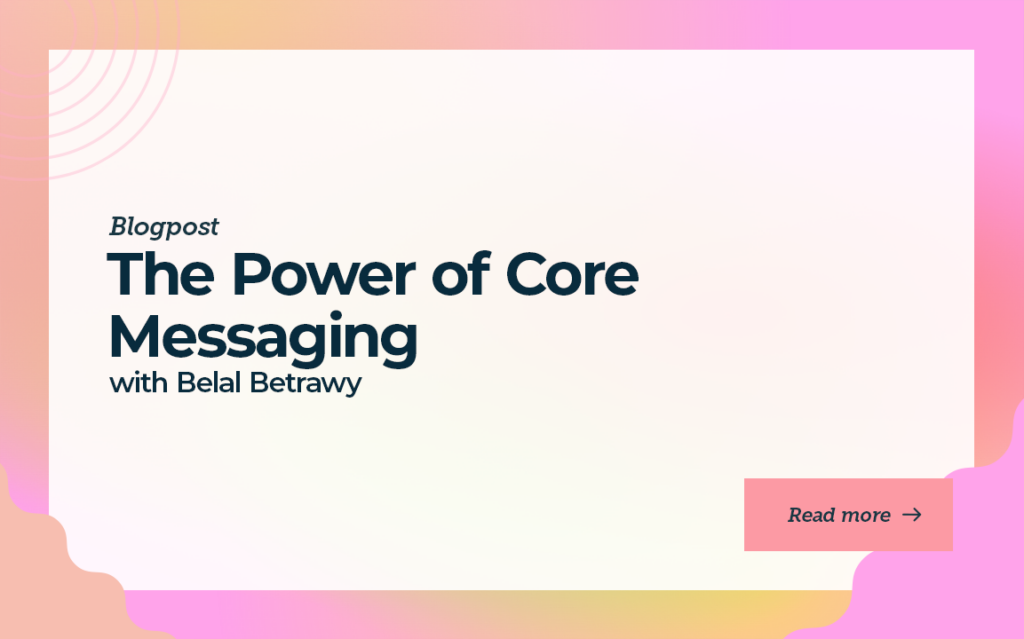The Power of Core Messaging with Belal Batrawy

In this episode, Collin Stewart is joined by Belal Batrawy, founder of Learn to Sell and Death to Fluff. They discussed the critical importance of core messaging in sales and how it can make or break your success.
The Importance of Core Messaging
Core messaging is essential for clearly and consistently understanding your company’s offerings. It helps position your product or service effectively, ensuring prospects appreciate its value. Misaligned messaging can create confusion, making it difficult for potential customers to recognize the relevance of your solution.
Messaging Pyramid: Is, Does, Means
Belal introduces the Messaging Pyramid to structure your messaging effectively:
- Is: Define what your product is. For instance, Snickers is a chocolate bar.
- Does: Describe what your product does. Snickers satisfies hunger with its combination of ingredients.
- Means: Explain what it means for the customer. Snickers helps you stay satisfied and energetic when you can’t have a full meal.
Aligning Team Messaging
Ensuring consistency in messaging across your team is crucial. When sales reps and marketing teams are not aligned, prospects receive mixed signals, leading to lost opportunities. Everyone on the team must communicate the same core message to maintain clarity and effectiveness.
Impact of Clear Messaging on Sales
Clear and consistent messaging can significantly impact sales outcomes. It helps potential customers quickly understand your value proposition, making it easier for them to make informed decisions. Conversely, unclear messaging can cause prospects to misplace your product or service, leading to lost deals.
The Role of Buyer Personas in Messaging
Developing meaningful messaging requires a deep understanding of your buyer persona. Tailoring your message to address your target audience’s specific needs, challenges, and situations ensures that your communication resonates and engages effectively.
The Power of Polarizing Messaging
Align your messaging with your top buyer personas by identifying the primary emotional triggers that resonate with them. This involves understanding the core problems and feelings that are universally relatable, ensuring your message hits the mark.
Craft polarizing messages to effectively filter out non-ideal customers. By creating content that forces people to choose sides, you attract those who align with your values and repel those who do not, enhancing customer loyalty and reducing wasted effort on non-prospects.
Utilize solid and provocative statements to evoke emotional responses. This method captures attention and drives engagement by making your message stand out and resonate deeper. Avoid safe, generic messaging that fails to provoke thought or emotional investment.
For instance, transforming generic claims into specific, emotionally charged statements, like changing “See your users over their shoulder” to “How do you know if people are rage-clicking on your product right now?” This makes the message more compelling and directly addresses a relatable pain point.
Establishing Credibility and Engaging Emotionally
Effective messaging starts with credibility. Buyers judge the message based on the credibility of the source. Snap judgments about credibility happen quickly, often influenced by factors like industry awards, recognized logos, or demonstrated expertise.
Establishing this early in your message sets a solid foundation.
Crafting a Compelling Worldview
Creating a compelling worldview is essential. This involves presenting a market insight or problem that forces the buyer to choose a side. It’s not about playing it safe but being provocative to evoke an emotional response.
This approach ensures that your message resonates deeply with those who align with your viewpoint, making your core audience feel understood and engaged.
Leveraging Emotional Triggers
Identify common emotional triggers across your top buyer personas. This could be a shared pain point or problem that elicits a strong emotional reaction. Craft your messaging to highlight these triggers, making your solution feel relevant and necessary.
For example, using relatable experiences like “rage clicks” on a frustrating website can vividly illustrate the need for your solution.
Constructing the Narrative
Building your narrative involves more than just presenting a solution. Explain why the problem exists and why it’s urgent to address it now. Define the stakes clearly to show what the buyer can gain or lose.
This deepens their understanding and makes your message more compelling.
Teasing the Solution
Finally, tease the solution by positioning the buyer as the hero. Instead of presenting your product as the hero, suggest what the buyer could achieve with your solution. This approach makes the buyer feel empowered and more likely to engage with your message.
By following these steps, you create a message that is not only credible and emotionally engaging but also strategically positioned to attract the right audience and drive action.
The Power of a Well-Structured Discussion Board
Establishing Credibility:
- Belal underscores the necessity of establishing credibility early in the conversation. For instance, FullStory leveraged its connection to Google by highlighting its team of ex-Googlers and backing them with Google Ventures. This quickly builds trust and sets the stage for the rest of the discussion.
Introducing a Compelling Worldview:
- A strong worldview is crucial to engage potential buyers. FullStory’s use of “rage clicks” as a concept to highlight user frustration is a prime example. This relatable issue grabs attention and makes the product a vital solution.
- “We asked ourselves a simple question… What if we could index all those interactions?”
Positioning the Buyer as the Hero:
- The buyer should always be the narrative’s hero, with the product as the tool enabling them to overcome their challenges.
- “You’re going to say the problem better than they can.”
Efficient Prospect Filtering:
- Using the discussion board early helps identify non-prospects quickly. A strong, provocative message ensures that those who don’t align with the worldview can self-select.
- “If the worldview isn’t accepted, then there’s no reason to go into that.”
Ongoing Discovery:
- Discovery is not a one-time event but an ongoing process. As new stakeholders join the discussion, the conversation must adapt to ensure continuous alignment with the buyer’s needs.
Key Takeaways:
- Credibility: Establish early through trusted associations.
- Worldview: Present a compelling, emotionally resonant issue.
- Buyer as Hero: Make the buyer central to the narrative.
- Prospect Filtering: Use strong messaging to identify actual prospects efficiently.
- Discovery: Keep the discovery process dynamic and flexible.
Iterative Messaging and Enhanced Sales Conversations
- Refining Core Messaging: Belal Batrawy emphasizes the importance of iteration in developing effective core messaging. At FullStory, it took seven iterations to finalize their messaging. This iterative process involved salespeople, ensuring that the final message was both compelling and embraced by the team.
- Impact on Conversations: High-quality messaging significantly improves the quality of sales conversations. When buyers feel that their problems are understood and articulated clearly, it builds credibility and trust. This leads to more meaningful and productive interactions between salespeople and buyers.
- Leveraging Sales Expertise: Sales teams often have more experience with specific problems than buyers. This expertise allows them to communicate solutions more effectively, positioning themselves as trusted guides in the buyer’s journey.
- Advanced Training: Belal’s boot camp offers advanced social psychology techniques to enhance discovery and sales conversations. These techniques go beyond traditional sales training and aim to elevate the skills of experienced salespeople.
- Practical First Meeting Tool: The discussion board is crucial for the first meeting with potential buyers. It helps establish credibility quickly, presents a compelling worldview, and gauges the buyer’s alignment with this perspective. This approach contrasts with traditional sales techniques that often jump directly into discovery.
Quotes to Highlight:
- “The quality of the conversation will change completely when you do it right.”
- “We were capturing their words in a way that they would never have the language to express again.”
- “It’s an iterative process. You might want to experiment with a couple of world views.”
Conclusion
Effective core messaging is crucial for ensuring prospects understand your product’s value. By iterating on your message, engaging emotions, and establishing credibility, you can resonate deeply with your target audience.
Key Takeaways:
- Iterative Development: Refine your messaging through multiple iterations to ensure clarity and effectiveness.
- Emotional Engagement: Use relatable experiences to create messages that evoke strong emotional responses.
- Establish Credibility: Build trust quickly with recognizable associations and demonstrated expertise.
- Buyer-centric narrative: Make the buyer the story’s hero, positioning your product as a tool for overcoming their challenges.
- Continuous Discovery: Keep the discovery process ongoing to adapt to evolving buyer needs and stakeholders.
Discover advanced sales techniques and elevate your team’s skills with Belal Batrawy’s boot camps at Learn to Sell and Death to Fluff.
Stay ahead in sales and revenue strategies by working with Predictable Revenue!
NO TIME TO READ?
Listen On:




